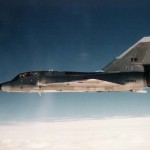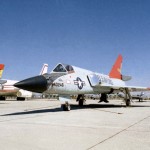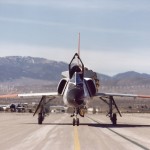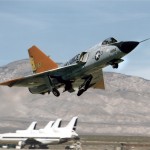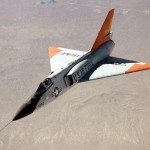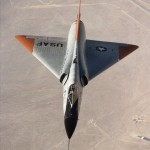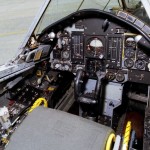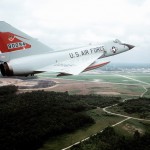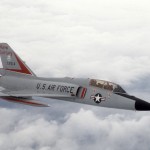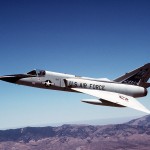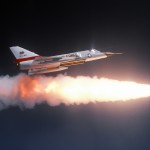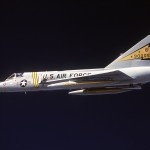
Like so many impressive pieces of the two Cold War machines, the delta-winged F-106 was designed to fight a battle that never came. It was so specifically crafted that it never saw action in the Vietnam War, despite its long record of service that started in 1959 and didn’t end until 1988.
Dubbed “The Ultimate Interceptor,” the Convair F-106 Delta Dart was an all-weather primary interceptor that was the US Air Force’s last airplane to fly dedicated to that role.
The F-106 came from the Air Force’s 1954 interceptor program, seeking an advanced fighter based on the F-102 Delta Dagger. The F-102 was a riveting success, with more than 1,000 built. But unlike the F-102, which did see action in Vietnam and was exported to Turkey and Greece, the Air Force ordered 342 F-106s and never exported the interceptor.
The F-106 was originally called the F-102B but was redesignated in 1956 because it had so many changes it was similar to the F-102 in shape only.
The “Delta Dart” featured the powerful Pratt & Whitney J-75-P-17 afterburning turbojet, letting the plane achieve Mach 2.
The plane had one mission and one mission only — shoot down enemy bombers before they could obliterate the United States. That was the very realistic fear of the 1950s. It could operate in all-weather and incorporated guided missiles as well as a guided nuclear missile or unguided nuclear rocket that could theoretically down many bombers in one shot.
In a marvel of emerging technology, the F-106 did not even need its pilot in order to engage in combat. It was equipped with the Hughes MA-1 integrated fire-control system, linked to the Semi-Automatic Ground Environment (SAGE) network. A controller on the ground could take control of the jet and fire its weapons. The F-106 was armed with four Hughes AIM-4 “Falcon” missiles, the first American guided air-to-air missile. It could also fire a single GAR-11/AIM-26A nuclear “Falcon” semi-active radar missile or a 1.5 kiloton AIR-2 “Genie.”
Pilots called the plane “The Six” and rarely used the “Delta Dart” moniker.
The McDonnell Douglas F-4 Phantom II was chosen over the F-106 for Vietnam missions. The F-4 had more advanced radar, better “Sparrow” missiles, higher thrust-to-weight ratio, better climb rate, and performed better at low altitudes. The F-4 also had ground attack capabilities, which the F-106 lacked. The F-106 also did not always have a gun mounted, but the F-4 carried one by default.
The AIM-4 “Falcon” was also a lousy missile against fighters. It was designed to shoot down huge Soviet bombers, and it was largely ineffective against small, fast Soviet fighters used by North Vietnam.
The F-106 never saw combat. One F-106, from the 102nd Fighter Interceptor Wing of the Massachusetts Air National Guard out of Otis Air Force Base intercepted and escorted a Tu-95 “Bear” bomber off Cape Cod in 1982. The F-106 was also deployed to Osan Air Force Base in Korea in 1968 to provide air defense during the “Pueblo” incident.
The F-15 began to replace the F-106 by 1981. The last “Sixes” left Air National Guard service in 1988.

Many of the F-106s were converted into QF-106 target drones and shot down during training missions.
At the tail end of the drone period, NASA’s Dryden Flight Research Center used the QF-106 for tests. In 1997 and 1998, Dryden ran a project called “Eclipse,” which sought to demonstrate the feasibility of a reusable tow-launch vehicle concept. According to NASA, the goal of Eclipse was to tow a QF-106 from the back of a C-141A transport and launching the QF-106. The tests demonstrated the validity of towing a delta-wing aircraft having high wing loading, validated the tow simulation model, and demonstrated various operational procedures, such as ground processing of in-flight maneuvers and emergency abort scenarios.
The Dryden days also produced some of the best photos of the F-106. NASA flew the F-106 until 1998. Today many surviving planes exist in museums and air bases around the country.
Specifications
General
Crew: 1
Length: 70.7 ft
Wingspan: 38.25 ft
Height: 20.28 ft
Empty weight: 24,420 lb
Engine: One Pratt & Whitney J75-17 afterburning turbojet, 24,500 lbf
Performance
Maximum speed: Mach 2.3
Combat radius: 1,800 mi
Range: 2,700 mi
Ceiling: 57,000 ft
Rate of climb: 29,000 ft/min
Thrust/weight: 0.71
Armament
Guns: One 20 mm (0.787 in) M61 Vulcan 6-barreled gatling cannon
Missiles:
- AIM-4 Falcon
- AIR-2A Genie nuclear rocket or AIM-26 Super Falcon missile, replaced with gun pod in 1972
Essential Reading
Online Resources:
- Wikipedia — Covers most of the bases, well-cited
- Dryden Flight Research Center — Photos and info on the Eclipse program
- f-106deltadart.com — Definitive resource for the F-106
